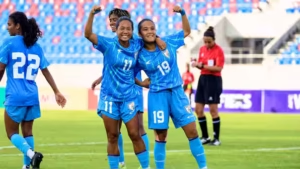Indian tennis recorded one of its most productive two-week phases of the 2025 season, with notable ranking improvements driven largely by results at the WTA 250 Chennai Open and steady progress across ATP Challenger events.
The period highlighted both the strategic value of high-level tournament access for Indian women’s doubles players and the grinding progression pathway essential for men’s players operating within the Challenger system. The most striking developments came from the women’s doubles draw in Chennai. Rutuja Bhosale rose 28 places to reach World No. 139, while her partner Riya Bhatia climbed to No. 183, up 21 spots. Both were boosted by their run to the semifinals, which delivered an estimated 110 WTA ranking points a significantly higher return compared to ITF-level event.

Their progress was defined by narrow margins. In the semifinal, they lost to the second-seeded Indonesian pair Sutjiadi and Tjen 7-5, 0-6, [5-10]. Despite the scoreline flipping sharply in the second set, the pair were statistically competitive across the match, winning 57 points to their opponents’ 59 overall. The result positions Bhosale just outside the functional threshold for consistent WTA 250 main draw acceptance, likely ensuring more stable inclusion in WTA 125 and higher-level ITF events over the next stretch.
For Bhatia, the ranking gain serves as confirmation of strong season-long doubles form. With both players now positioned inside the Top 200, their partnership gains strategic viability for regular international scheduling and tournament entry, providing continuity that has often been missing in India’s doubles ecosystem.
The most dramatic leap of the fortnight came from Vaishnavi Adkar. Her jump of 148 places to World No. 461 represents a complete revaluation of her ranking position, directly attributable to a quarterfinal run in Chennai. Prior to this tournament, Adkar had been competing primarily in W15 and W35 ITF events, where ranking progress is typically slow and incremental.
The 60-point haul from a single WTA 250 quarterfinal replaces a year’s worth of smaller results on the rankings table, creating what coaches refer to as a “springboard effect” an immediate transformation in a player’s competitive scheduling opportunities.
Adkar’s doubles progress also came with a singles wildcard opportunity, where she entered the Chennai main draw as a Lucky Loser and faced third seed Donna Vekic in the opening round. While she did not advance, the exposure is strategically valuable. More importantly, her new doubles ranking ensures direct entry into higher-tier ITF events (W60/W75), where the competitive ceiling aligns more closely with long-term development goals.
On the men’s side, ranking gains were steadier but strategically significant. S D Prajwal Dev rose five spots to a career-high doubles ranking of 235.
The movement is modest in numerical terms but represents successful point defense at the Challenger level, where retaining ranking position requires sustained consistency against deep, competitive fields. His position inside the Top 240 also changes his entry profile improving his chances of securing direct acceptance into Challenger doubles main draws, reducing reliance on qualifiers or wildcards.
For Aryan Shah, progress came on both rankings lists. He climbed three places to World No. 385 in singles and one place to No. 404 in doubles.
Operating in the 300–450 ranking band is often where Indian players struggle due to the volume and financial demands of the ATP Challenger tour. Shah’s stability indicates that his base level is now aligned with the competitive expectations of this tier. His record of 36 wins and 26 losses for the season reflects meaningful match volume a crucial metric for sustaining progression.
These twin progressions sharp leaps on the WTA side and incremental consolidation on the ATP side underline the asymmetry between the two ranking ecosystems. A single WTA 250 breakthrough can generate rapid upward mobility, while Challenger-level progress typically requires months of sustained workload for smaller gains.
For Bhosale and Bhatia, the priority over the next quarter will be structured planning to convert WTA 250 semifinal-level performance into consistent main draw presence. For Adkar, the next phase requires stabilizing at W60/W75 level to ensure the Chennai result becomes a foundation rather than an isolated spike.
For Dev and Shah, the focus is narrower: breaking the ATP Top 200 barrier. Doing so unlocks more efficient tournament scheduling, stronger partnership options, and greater rate of point retention. The late-October shift marks a meaningful step forward but the sustainability of this momentum will depend on calendar planning, targeted event selection, and continued access to high-value tournament weeks.
How useful was this post?
Click on a star to rate it!
Average rating 5 / 5. Vote count: 2
No votes so far! Be the first to rate this post.






